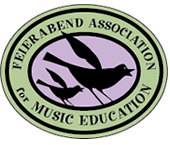BRIDGES TO THE COMMUNITY SERIES: HOW TO HOST A FAMILY FOLK DANCE
Lillie H. Feierabend, FAME Teacher Trainer
Often a single experience will open the young soul to music for a whole lifetime.
This experience cannot be left to chance. It is the duty of the school to provide it.
Zoltan Kodaly, Children’s Choruses, 1929
 I take this charge to heart. Teachable moments do not always happen in the music classroom. Regardless of the excellence of our materials, sequencing and passion, we have no guarantee that students will be moved by music in the short amount of time they are with us. But, if we look just beyond the limits of the music classroom, we can create other experiences capable of engaging and influencing, not only our students, but our greater school community, as well, and most significantly, our families.
I take this charge to heart. Teachable moments do not always happen in the music classroom. Regardless of the excellence of our materials, sequencing and passion, we have no guarantee that students will be moved by music in the short amount of time they are with us. But, if we look just beyond the limits of the music classroom, we can create other experiences capable of engaging and influencing, not only our students, but our greater school community, as well, and most significantly, our families.
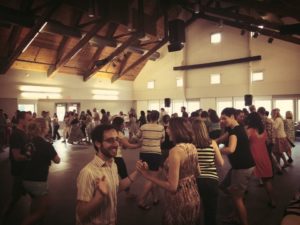 Over the course of this coming year, I would like to share twelve ideas to help build bridges from your music classroom to your students’ homes, from your school to your community, and offer parents the opportunity to musically engage with their children while learning about your curriculum and the powerful role music plays in the growth and development of their children. I have found that the more information parents have, the more likely they are to support our music programs.
Over the course of this coming year, I would like to share twelve ideas to help build bridges from your music classroom to your students’ homes, from your school to your community, and offer parents the opportunity to musically engage with their children while learning about your curriculum and the powerful role music plays in the growth and development of their children. I have found that the more information parents have, the more likely they are to support our music programs.
In this second article, I would like to share the idea of a Family Folk Dance. It takes no money, no additional materials and practically no time, but helps create another environment where all members of the school community come together and are given the tools to play an important part in a child’s musical development.
WHO?
Everyone; students, parents, staff, faculty, administrators, all joyously moving together. Even the youngest members of your community can be included and be successful at their own developmental level.
WHAT?
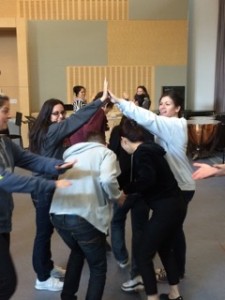 All the wonderful dances that are already in your curriculum and that you already teach; stationary partner/quartet clapping games (Miss Mary Mack, Four White Horses), moving circles without a partner (Zemer Atik), moving circles with a partner (La Bastringue, Fjaskern), Sicilian Circles (Black Joke), Longways Formation (Chimes of Dunkirk, Bridge of Athlone), Play Parties (Shoo Fly, There Were Four Sailors), Snowball Mixers (Rig-a-Jig-Jig), and Move Its! (Soldier’s Joy). These wonderful examples can be found in collections by The Amidons, Sanna Longden, Phyllis Weikart, and John Feierabend. Make sure to download my Never-Fail Favorite Family Folk Dances at the end of this article.
All the wonderful dances that are already in your curriculum and that you already teach; stationary partner/quartet clapping games (Miss Mary Mack, Four White Horses), moving circles without a partner (Zemer Atik), moving circles with a partner (La Bastringue, Fjaskern), Sicilian Circles (Black Joke), Longways Formation (Chimes of Dunkirk, Bridge of Athlone), Play Parties (Shoo Fly, There Were Four Sailors), Snowball Mixers (Rig-a-Jig-Jig), and Move Its! (Soldier’s Joy). These wonderful examples can be found in collections by The Amidons, Sanna Longden, Phyllis Weikart, and John Feierabend. Make sure to download my Never-Fail Favorite Family Folk Dances at the end of this article.
If you know four dances, you are ready to lead an hour-long Family Folk Dance. Anticipate about 15 minutes for each dance; play a bit of the music for a hint of the tempo and spirit, teach one part at a time, careful to connect each section to the previous section, put the music on again, making sure to cue the next movement a beat or two prior, and let the fun begin!
WHERE?
Perhaps the gym, cafeteria, or music room. If I have 120 guests, we use the gym; if 20 show up, I use my music room. Don’t feel disappointed if 20 people attend; those are the 20 people who were able to come. Everyone wantsto come, but circumstances, especially with young children, can change at the last minute. My motto is, “Come when you can, leave when you must.”I always assure parents who state how disappointed they are that they weren’t able to attend, that we look forward to seeing them at the next folk dance. If your population is too large for the space, consider dividing; half the school one time, and the other half at another time.
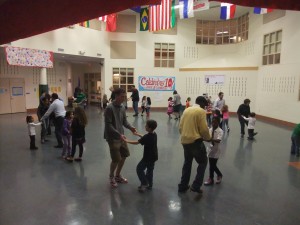 Once you look outside the music classroom, additional opportunities become apparent. Through the years, I have also led Father/Daughter Dances, the Girl Scouts, School-Wide Hoedowns, and May Day Celebrations. I have led Folk Dances that were fund raisers and others that were celebrations of grade-level and school-wide cultural studies, and as Periods of Discovery, and Enrichment classes. I have shared these ideas at local, state and national conferences with others who want to create this opportunity for their community. Because we believe so strongly in this, we also host a yearly Strawberry Social with dancing in our driveway as an opportunity to introduce others to the wonderful world of Community Folk Dancing.
Once you look outside the music classroom, additional opportunities become apparent. Through the years, I have also led Father/Daughter Dances, the Girl Scouts, School-Wide Hoedowns, and May Day Celebrations. I have led Folk Dances that were fund raisers and others that were celebrations of grade-level and school-wide cultural studies, and as Periods of Discovery, and Enrichment classes. I have shared these ideas at local, state and national conferences with others who want to create this opportunity for their community. Because we believe so strongly in this, we also host a yearly Strawberry Social with dancing in our driveway as an opportunity to introduce others to the wonderful world of Community Folk Dancing.
WHEN?
Anytime that works for you and your community is perfect. I have two each year, one in the fall and one in the spring, which 1) sets up an expectation and, 2) lets parents know that if they miss one, there will always be another opportunity. The Family Folk Dance is the first activity my principal schedules each year because he views it as a wonderful ice breaker; families come in as strangers but leave as friends after having spent an hour dancing and clapping together. What works best for my school is 6:30 – 7:30 on a Thursday evening.
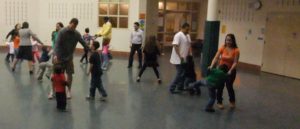 Because time is so precious for parents with young children, consider linking it to other activities. For instance, each October we invite families to come for our Fall Festival. In ninety minutes, families rotate through a Barn Dance with me in the music room, Pumpkin Painting with the art teacher in the art room and a Chili Pot Luck in the cafeteria. So, by coming for one evening, families are able to dance together, paint together, and eat together, enjoying the community and camaraderie provided by the school. Great fun!
Because time is so precious for parents with young children, consider linking it to other activities. For instance, each October we invite families to come for our Fall Festival. In ninety minutes, families rotate through a Barn Dance with me in the music room, Pumpkin Painting with the art teacher in the art room and a Chili Pot Luck in the cafeteria. So, by coming for one evening, families are able to dance together, paint together, and eat together, enjoying the community and camaraderie provided by the school. Great fun!
Schedule your first (or next) Family Folk Dance right now. It is best to have it on the initial school calendar rather than adding it later. Let everyone know it is coming, the month before, the week before, and the day before. Let your students be ambassadors for this wonderful opportunity to gather.
WHY?
To create community and foster connections between home and school, between faculty and staff, between administrators and families. Bringing everyone together in such a welcoming way is the essence of creating a Positive School Climate. Make the first connection a positive one; It is much easier to communicate with someone after having spent an evening laughing with them, it does break the ice.
This also offers a wonderful way to show correlation among subjects. If one grade is studying a particular country and you have been integrating representative dances, why not teach one or two during the Family Folk Dance.
HOW?
This is the topic that generates the most concern. Teachers eagerly schedule dances, only to watch as students enter and run in circles. Or watch as guests enter and eat and drink. Or watch as parents enter, sit down, and watch as their children dance with the teacher. All of this is understandable, but do not let it drive the Folk Dance. Establish routines that make guests comfortable from the very beginning and proactively guide them to an enjoyable hour of family dancing.
Here are a few words of wisdom gleaned from decades of leading Folk Dances.
- Try not to serve food: It will detract from the dancing. It also has the potential to become messy. If food needs to be served (Pasta Supper, Chili Pot Luck, cultural celebrations, Father/Daughter Dinner etc.) schedule it as a separate offering before or after the dancing. Water is the most suitable thirst quencher, anyway. The whole point of the dance is for everyone to be together.
- Try not to put out chairs. If you do, some parents will come, sit and watch you play with their children. We do this during the day; the Folk Dance is theiropportunity to play with theirchild, free of distractions. I do keep an eye on my guests as they enter and if there is a need, of course, I will put out a chair or two.
- Get everyone moving appropriately and with purpose the moment they walk in the room! There are two concerns that if not addressed, will derail your plans for an enjoyable and successful evening for all. We know that the first thing a child will do upon entering a large space is run around in circles. If you allow this, you will be reactive, and not successful, in trying to stop them and corral them into a circle. Also, experience teaches us that not everyone can be there at the same time, at your call time. Should you wait until “more’ people show up? If you do, you will have taught your guests that it didn’t matter that they came on time and therefore, they may not the next time, which is not successful, either. Here is where the crucial and critical decision of the first dance plays a significant role. Here is also where knowledge of Phyllis Weikart’s sage advice to Separate, Simplify and Facilitatecan set the tone for a successful evening. This knowledge has also become my Teaching Strategy for every dance, finger play, song, clapping game, play party, instrument selection, literally, everything I teach.
Put yourself in your guests’ shoes. How would you feel if, arriving late and not particularly comfortable with “dancing,” you enter what may be a new space with unfamiliar faces and find everyone up and moving and laughing? You would probably feel uncomfortable and lost and perhaps decide to “sit this one out.” I always think of my most vulnerable guest and do everything in my power to anticipate and hopefully alleviate any concern that might arise. So…..
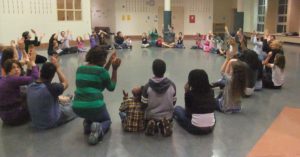 Begin SEATED on the floor. Invite all to join you as they come into the room, whenever they come into the room. You have given them purpose and direction. They will quickly put down any items in their hands and come join you in the seated circle. The wonderful thing about a circle is that it will expand to accommodate guests as they enter, there is always another place.
Begin SEATED on the floor. Invite all to join you as they come into the room, whenever they come into the room. You have given them purpose and direction. They will quickly put down any items in their hands and come join you in the seated circle. The wonderful thing about a circle is that it will expand to accommodate guests as they enter, there is always another place.
Begin with How Do You Do-Ti (Longden, Feierabend – downloadable at the end of this article). Using Weikart’s strategy, I know How Do You Do-ti has three distinct modalities; the chant (verbal), the arm and head motions (non-locomotor or stationary), and walking (locomoting, moving from one place to another). For meaningful learning to take place, each of these needs to be addressed separately.
Begin to teach the chant after a few minutes of greeting and chit-chat (about three minutes). Speak it in its entirety a few times, then have guests echo phrase by phrase, then two phrases, then all four. This allows those that are straggling in to enter quickly and join you in the ever-expanding circle. By being seated, with just the chant, your guests will immediately feel comfortable; no worries about intricate footwork and sequencing they may have missed. It is a very comfortable, inviting and inclusive beginning.
By the time you do have critical mass, about 5-7 minutes later, and guests are familiar with the chant, begin to add the arm and head motions and allow them to again practice each phrase, this time with the addition of the motions, then put two phrases together, then finally all four. You will have proactively used what could have been wasted time as guests waited, and instead taught them a part of the dance.
Then, when you have done everything in the “dance” except walk, stand and perform everything as before, with the addition of walking to another place in the now standing circle. Let the fun begin!
I know the previous section is lengthy and perhaps feels as if it might take up the entire Family Folk Dance. Rest assured, this entire sequence and the dance will only take about 15 minutes. By separating the modalities and teaching the most accessible modality first (words), guests are able to begin learning even as others enter. This first “dance” will also give you a good idea of your guests’ comfort level and abilities, which in turn, will help you decide on your selections for the evening.
Teaching a Dance with Music Play the music first to give a sense of the tempo, spirit and mood. This will help guests anticipate a joyful experience and remind you of the tempo. Inform them of what to expect in the introduction (not all dances have an introduction) and you should know how many rotations in a dance so you can cue that, as well, bringing the dance to closure in a musical meaningful way. Decide how many sections the dance has and then teach section by section. Speak and walk guests through each section first and invite them to mirror your motions and echo the instructions. Repetition helps reinforce both. When they are comfortable, go on to the next section, making sure to connect the new to the old and connect the end back to the beginning so there is no loss of momentum. Anticipate difficulties and teach to them. Teach in a way that guarantees success and then build on that success. Cue one to two beats prior to each new move. Sing or chant directions and make sure they fit the rhythm of the music but become less evident as your guests become more capable. The more they are able to do, the less they require from you. Be aware of when that happens but be ready to resume should the need arise. Sometimes using a small group to demonstrate works well to give an idea of the whole.
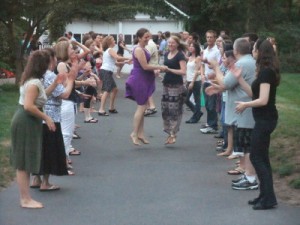 This sequence will NOT bore anyone. The more the steps are repeated, the more familiar they become, the greater the ease and success with which your guests will participate. They will have a great time. These may be dances you have already taught but they should be simple enough that you could teach them to all on the spot. Keep it simple. The point is to create a warm inviting atmosphere for everyone to gather and share the dancing. Make it successful for all. To that end, be flexible; have several dances of various types and difficulties ready, because what you actually teach will depend on the age, abilities and comfort level of your guests that evening.
This sequence will NOT bore anyone. The more the steps are repeated, the more familiar they become, the greater the ease and success with which your guests will participate. They will have a great time. These may be dances you have already taught but they should be simple enough that you could teach them to all on the spot. Keep it simple. The point is to create a warm inviting atmosphere for everyone to gather and share the dancing. Make it successful for all. To that end, be flexible; have several dances of various types and difficulties ready, because what you actually teach will depend on the age, abilities and comfort level of your guests that evening.
By providing an opportunity outside the music classroom, we are meeting Kodaly’s challenge. Chances are, dancing with parents, or the principal, playing a clapping game with classroom teachers, laughing with siblings, or helping teacha dance, just might ignite the spark and capture the soul of that child for a lifetime.
A list of my Never-Fail Favorite Family Folk Dances may be downloaded below. As promised, it has several categories of dances, each with a range of difficulties. The number in parentheses (1- 10) after each dance corresponds to the same number on the second page, which is the title and author of the resource. Have fun!
